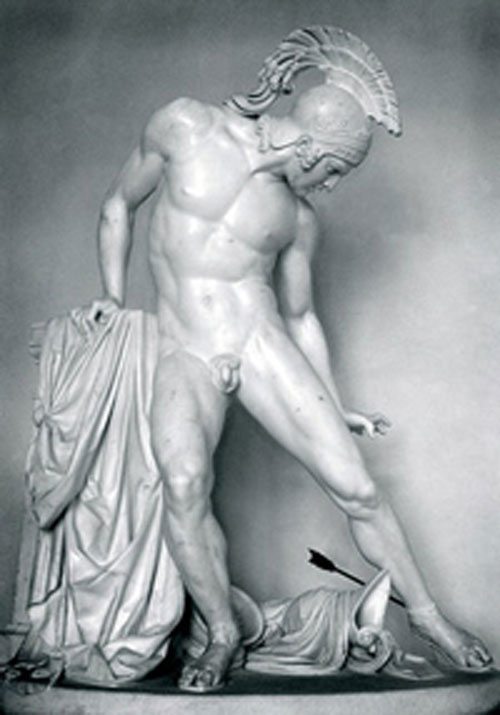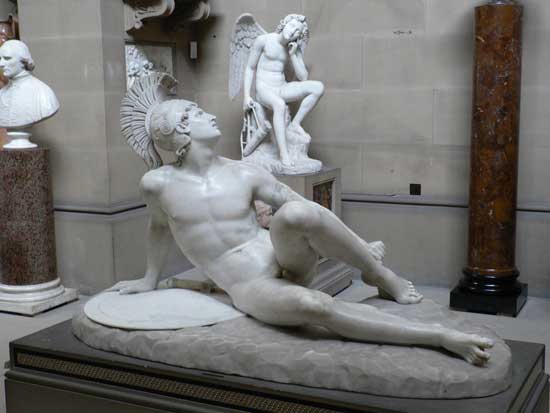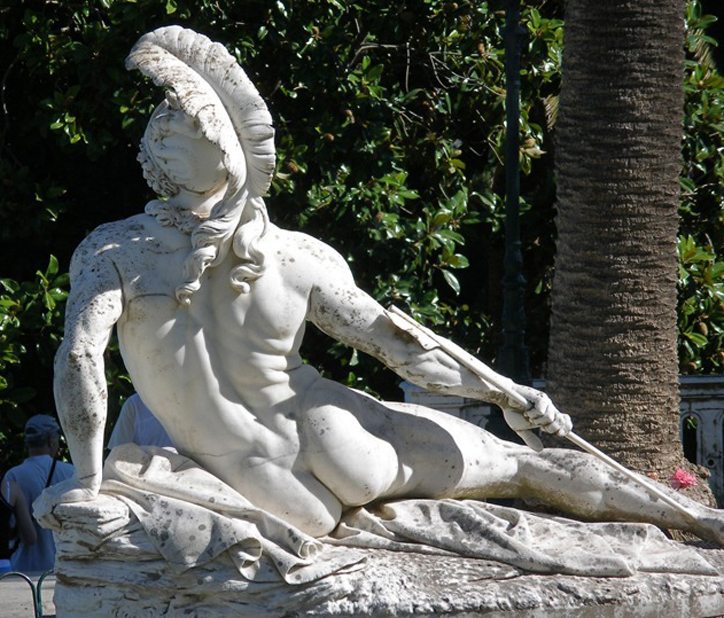Three Ideals on Which Classical Greek Art Is Based
 In the ancient world it was the almost compatible belief that the Trojan War was an historical upshot… but so, as now, everyone knew at that place was no principal source for the state of war; equally they knew that it had happened! * The discovery of a fine French figural group in bronze in a Sydney antique store, depicting a young Achilles being educated by the centaur Chiron, had me pondering humankind'southward capacity for learning, adapting and improving.
In the ancient world it was the almost compatible belief that the Trojan War was an historical upshot… but so, as now, everyone knew at that place was no principal source for the state of war; equally they knew that it had happened! * The discovery of a fine French figural group in bronze in a Sydney antique store, depicting a young Achilles being educated by the centaur Chiron, had me pondering humankind'southward capacity for learning, adapting and improving.
Information technology becomes evident when you view this delightful piece of work, a statuary dating from 1860 and fabricated at Paris, the acknowledged centre of artists and sculptors past the middle of the nineteenth century. It was left unsigned, so we cannot e'er really know who made it, except through attribution.
This work of art was conceived during an historic period when men set out to rediscover the virtues of the classical ideal in art and architecture, based on wide ranging archaeological and bookish inquiry.

Education of Achilles by Jean Baptiste Regnault (1754-1829) Louvre, Paris
47.5 cm high and 49.v mm wide and beautifully modeled after a painting by Jean Baptiste Regnault (1754-1829) in the Louvre Museum at Paris, information technology is quite my thing really, because since equally far back as I can remember I accept always preferred sculpture to painting.
Producing an image human or hero in stone, marble or bronze has to me always seemed quite miraculous. One of my favourite of all legendary Greek heroes to be viewed in sculpture is Achilles, whose dramatic developed story is told by the epic poet Homer in his masterwork The Iliad.

Achilles Wounded by the Heel past Charles Alphonse Achille Gumery
Greek sculpture was the kickoff and only ancient art form to break free from conceptual conventions, exploring how art might imitate nature, or even improve upon information technology.
Over the centuries since those who valued its beauty and timeless aesthetic sought to conserve and preserve examples excavated by archaeologists by copying them.
Much of the ancient Greek sculpture we know almost today is because of afterward Roman copies.
The archetype manner was based primarily on the male nude, whose form dominated the visual arts of the western world for nearly two and a half millennia.
Achilles equally a subject area stood tall among the pantheon of Greek Gods and heroes, although he was half mortal.
Despite his seeming perfection, while striving to win our admiration Achilles was, and always remains bailiwick to human frailty. Maybe that's why we can still connect with him today?

Brad Pitt playing Achilles in the movie Troy – the perfect male version of a 10
The ancient Greek civilisation was built on the foundation of the heritage established during the Greek Mycenaean flow. Mycenaean culture dominated the eastern Mediterranean world from the 15th to the 12th century before the Christ Result.
Together with nearby metropolis state Tiryns, Mycenae played a vital part in the evolution of classical Greek culture.
Information technology confirmed its grapheme by building on the legacy of the intellectual ideas, philosophies and values of each metropolis state as ane great creative force.
Mycenae was a natural rock citadel and capital of the legendary King Agamemnon. From the hill on which the palace was located its people could see across the Argolid, a region in the Peloponnese mountains, all the manner to the Saronic Gulf, which is part of the Agean Bounding main.
The Mycenaean civilisation developed in the late Bronze age, so to use this cloth to produce classical statuary has always seemed to me virtually appropriate.
One of the final ventures overseas of the Mycenaean Greeks was the reputed major expedition against Troy.
Legend tells us Rex Agamemnon besieged the ancient city for ten years, before taking it past deceit by hiding soldiers inside the gift of a huge wooden horse.

Another superb Achilles wounded past the heel, this one in the Villa Reale, Milan by Innocenzo Fraccaroli (1805-1882) an Italian sculptor, who won Brera Academy'due south 1829 prize for sculpture
One of the neat sculptural images of Achilles, Greek hero of legends rendered during the nineteenth century, was a life size effigy created past Charles Alphonse Achille Gumery (1827 – 1871) a student at the École des Beaux-Arts at Paris.
In 1850 Gumery won the prestigious Prix de, a competition first created in 1663 past Louis Fourteen, for his sculpture Achilles Wounded in the Heel past Paris.
The son of the mortal Peleus and the sea nymph Thetis, when Achilles was a boy a seer, Calchas, prophesied the city of Troy would non exist taken without his help.
His mother alarmed, every bit i story goes, held him past his heel and dipped him into the fabled river Styx (separating the world of the living from that of the dead).
She believed if the water covered him he would live forever. However every bit she held him by his heel it remained dry and therefore, unprotected.
When he was a child Achilles was given over into the accuse of Chiron who had the expertise to equip Achilles with the skills necessary to protect his life at all times. 1 of those was archery, the subject for our sculpture and the weapon that would eventually bring about his demise.
Afterward his educational activity was complete his female parent hid him away in disguise. However Odysseus, Greek king of Thrace discovered his truthful identity and took him to the city of Troy.
Achilles captured 23 towns and was given a war prize, a woman – Briseis. The armed forces leader of the Greeks Male monarch Agamemnon took her from him and Achilles was and then enraged that he refused to fight for the Greeks ever again.

The wounded Achilles in the Sculpture Gallery, Chatsworth
His friend Patroclus, wanting to requite him time to recover, stole his armour and fought in his identify. Patroculus was killed by the Trojan hero Hector, who idea he had slain Achilles.
When he discovered what had happened Achilles was overwhelmed with both grief, and guilt, at the expiry of his friend.
He returned to kill Hector, dragging his body backside his chariot exterior Troy's walls in an human activity of uncharitable desecration that went on for days.
Hector's begetter Priam came to the Greek army camp in disguise and begged Achilles for the return of his son'southward body, so that he could exist cached according to tradition.
Achilles, in respect for the old human being's grief relented, granting his wish and graciously assuasive him to take Hector'southward body away, revealing his ability for compassion.

Archaeological site of Troy
Ironically it would be Priam's youngest son Paris, whom Helen had run away with causing the Trojan State of war in the showtime place, who would finally shoot the arrow into Achilles' heel, bringing him down.
High german businessmen Heinrich Schliemann 1822 – 1890, every bit well as others, excavated the site. Schliemann funded his ain search for the Greek heroes every bit recorded by ancient Greek poet Homer in his work The Iliad. He wanted to see if they had actually existed and that legend was in reality based in truth.
His earthworks of the site, thought to exist the Troy of fable uncovered impressive architectural remains.
They found a well-fortified citadel with strongholds for soldiers, weapons and officials, as well equally storerooms for grain in case of siege.
The wealth of the community had been invested in their King, whose treasures like Egyptians had been placed in his tomb.

The wounded Achilles at Corfu
Archaeologists during the twentieth century disputed the level Schliemann had idea was the legendary setting for the celebrated battle for Helen of Troy, 'the face that launched a thousand ships'.
The site yielded the ruins of more than six cities, which had all been rebuilt on 1 spot besides as a regal treasure of gilt.
Chatsworth House at Derbyshire in England is ane of its greatest treasure houses for the visual arts. Annually it draws yard and thousands of art-lovers, collectors and coincidental visitors, both immature and former.
 One of the most popular spaces in the house is the sculpture gallery of the 6th Duke of Devonshire. William Spencer Cavendish became the 6th Duke in 1811.
One of the most popular spaces in the house is the sculpture gallery of the 6th Duke of Devonshire. William Spencer Cavendish became the 6th Duke in 1811.
As part of his development of Chatsworth Business firm, during the 1820s and early 1830s, he created a new n fly that included a Sculpture Gallery to business firm his collection of contemporary sculpture, the majority of which was sourced in Rome, and other rare and precious marbles.
A major project to re-display the sculpture gallery began in 2008 and was completed in 2009. It includes another simply sensational sculpture by Italian sculptor Filippo Albacini (1777 – 1858) of Achilles, our aboriginal Greek hero, who was modelled so beautifully past so many artists in the nineteenth century and, after the classical ideal.
Carolyn McDowall, The Culture Concept Circle, 2012 – 2014
*Michael Forest – In Search of the Trojan War (p 26-27)
Source: https://www.thecultureconcept.com/achilles-greek-hero-and-the-classical-ideal-in-sculpture
0 Response to "Three Ideals on Which Classical Greek Art Is Based"
Postar um comentário